Lobelia erinus
Are you looking for a compact and reliable annual to add some bright splashes of color throughout the garden, even in the cool or shady spots?
An old-fashioned charmer, garden lobelia fits the bill perfectly.
It flowers in nonstop waves of brilliant blues, pinks, purples, and white all summer long, and has pretty, dainty foliage.
This plant is notable for having two different growth habits available, and gives wonderful versatility in the garden or containers.
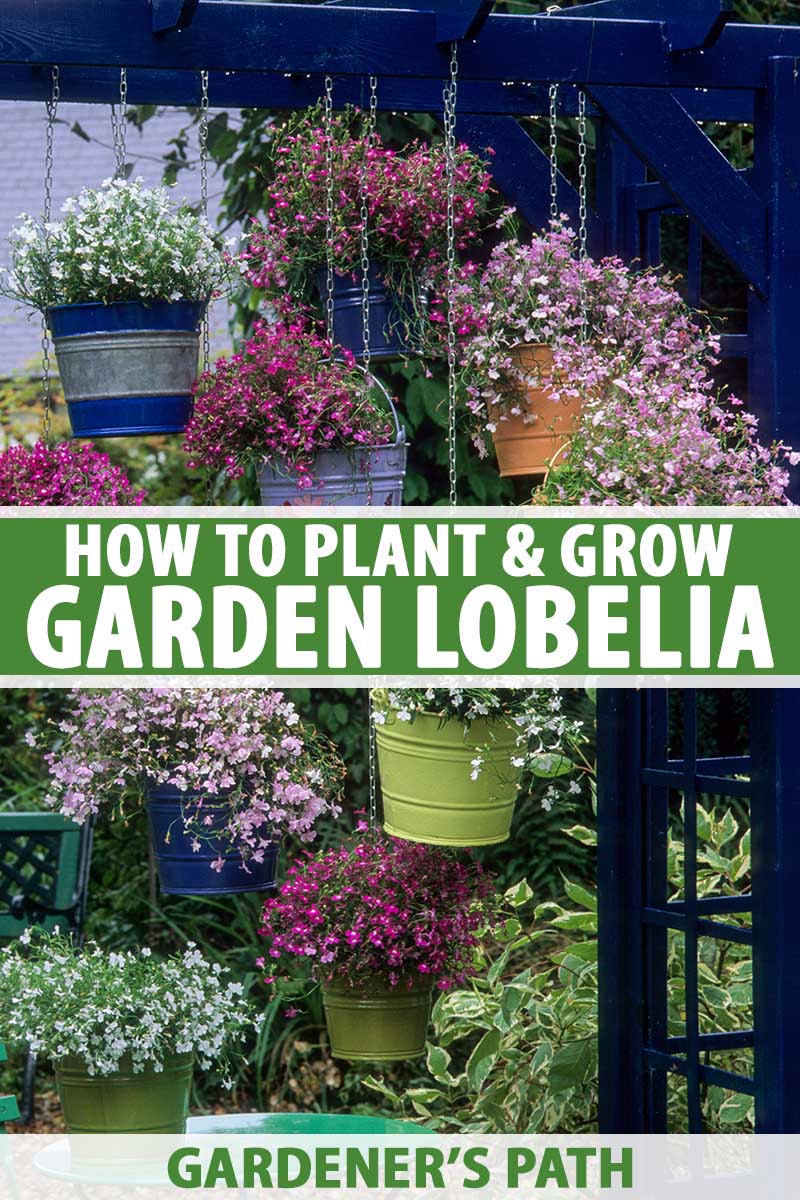
We link to vendors to help you find relevant products. If you buy from one of our links, we may earn a commission.
Compact varieties with an upright growth habit are a natural for edging or as fillers in flower beds.
And the trailing varieties have a lush, spreading habit that are superb cascading out of containers, hanging baskets, and window boxes – or spilling over rockeries and retaining walls.
Plus, they’re fast-growing and easy to cultivate from seed at home.
Vibrant and virtually pest free, you’ll soon find out why the Victorians got hooked on these delightful, low-maintenance plants!
Here’s everything you need to know about how to plant and grow Lobelia erinus.
What You’ll Learn
Cultivation and History
L. erinus is one of over 400 species in the genus Lobelia. A dwarf species, it’s commonly known as annual, edging, garden, or trailing lobelia.
It gives a lush and reliable display, making it highly popular for containers, border edging, short-season fillers, hanging baskets, rockeries, and window boxes.
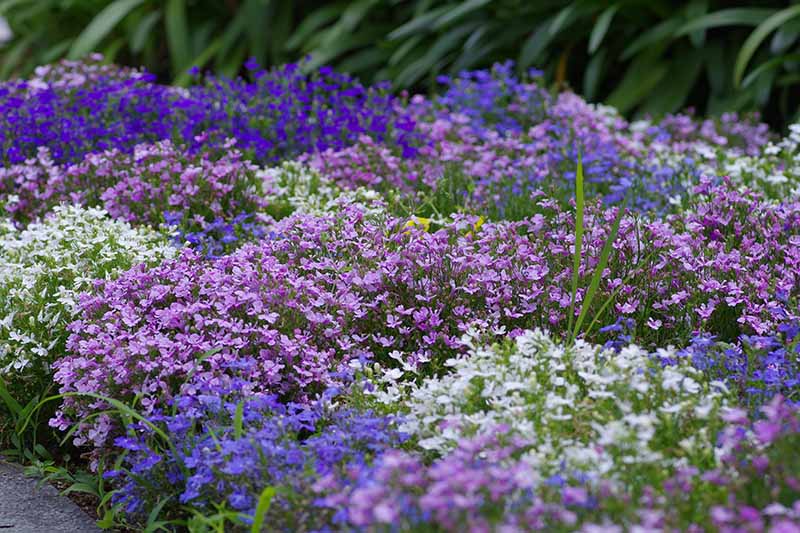
This tender perennial is typically grown as an annual for its low and trailing growth habit that provides terrific ornamental value anywhere it’s planted.
A member of the bellflower or Campanulaceae family, the small tubular flowers have a large, fan-shaped lower lip of three fused sepals and a two-sepal upper lip in intense shades of blue, mauve, pink, violet, and white.
The two-lipped flowers grow in large clusters and often feature attractive white eyes. Plant foliage is light and lacy, with thin ovate leaves and serrated edges.
Highly attractive to butterflies and other pollinators, plants bloom from mid spring to early autumn. They thrive in cooler temperatures and make an excellent choice for areas with dappled or light shade.
Lobelia can also be grown as a perennial where winter temperatures remain above freezing.
In both the upright and trailing forms, mature dimensions are typically four to nine inches tall with a spread of eight to 16 inches.
Native to southern Africa, L. erinus was first introduced into Holland from the Cape province of South Africa in the 1680s.
It made its way to England around 1760 and became a star of the Victorian “bedding” craze – the vivid blues were a favorite for mass planting in the front of large, colorful beds.
Thanks to its wild popularity with the Victorians, lobelia arrived in North American gardens in the mid-1800s.
Within the genus are some well-known North American wildflowers that make attractive perennials in the garden as well.
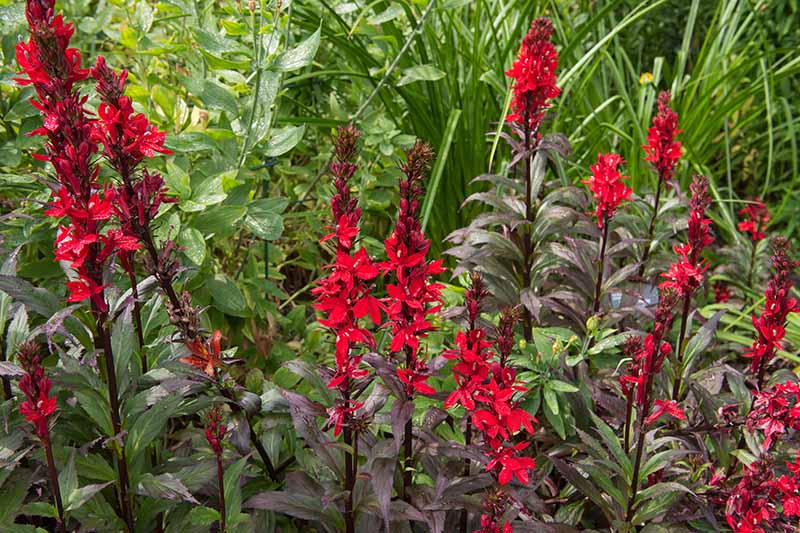
Cardinal flower (L. cardinalis), is a popular perennial for its tall, showy spikes of scarlet-red flowers.

Great blue lobelia (L. siphilitica), or blue cardinal flower, is another perennial wildflower with long-lasting, tall stems that feature bright blue flowers.
Garden Lobelia Propagation
Lobelia seeds are extremely small and fine-textured but are easy to cultivate if started indoors eight to 12 weeks before transplanting out – generally, two to four weeks after your last frost date.
Direct sowing outdoors after the average last frost date in your area is possible, but germination is much less reliable and indoor sowing is recommended.
Because the seed is so fine, seedlings often mat together and can be difficult to pull apart when transplanting.
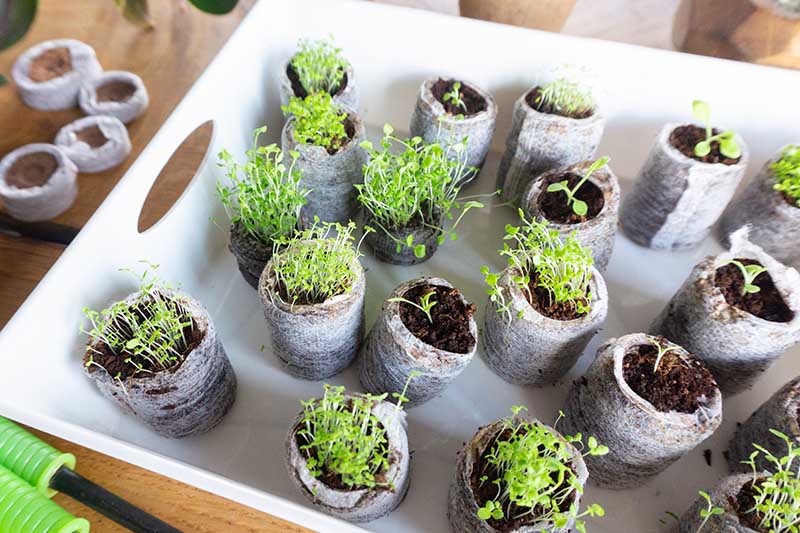
For this reason, pellets, or trays with 12 or 24-cell plug inserts, help to make transplanting easier – and with less plant loss.
These 12-plant trays are well suited for starting lobelia. The divisions make for easy transplanting and they come with a humidity dome that assists germination.
Seed Starting Trays with Humidity Dome
Six-packs of trays are available at Home Depot.
Some nurseries sell seeds as “multi-seed pellets,” with multiple tiny seeds that are are coated in an inert substance to create a larger pellet for easy sowing.
Add a good seed starting mix to the cell packs and gently sprinkle the seed on top of the soil. Use a small spoon to disperse the seed as evenly as possible over the entire surface area.
Do not cover seeds with soil, but gently firm the planting medium down with your fingertips after seeding. Seeds require light to germinate.
Place in a location with a bright light – or under a grow light – and a soil temperature of 65-75°F. You can use a heat mat if required.
Provide bottom watering or water gently with a mist sprayer to avoid disturbing the seeds. Keep the soil evenly moist but not wet.
Cover with a clear hood or place in a polythene bag to keep seeds moist and warm. Germination occurs in 15 to 21 days.
After four to six weeks, when seedlings are two to four inches tall, you can start to gradually harden them off to prepare them for outdoor conditions.
Despite their preference for cool weather, they won’t survive a late spring frost – don’t plant out until nighttime temperatures remain consistently above 60°F.
To harden off, place seedlings in a sheltered location outdoors for an hour a day, and gradually extend the time they spend outside over the course of a week or two.
When transplanting seedlings or nursery starts into beds or containers, plant at the same depth and width as the container they are growing in. Space seedlings four to six inches apart.
How to Grow Garden Lobelia Flowers
Plants do well in full sun to part shade and require well-draining soil enriched with organic matter.
Lobelia is adaptable to most soils but does best in slightly acidic conditions with a pH of 5.5 to 6.5
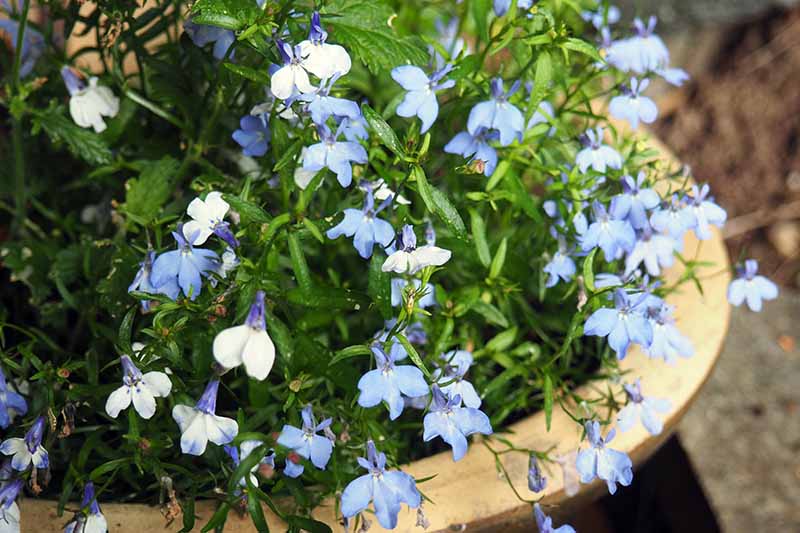
They thrive in the coolness of spring, and older varieties benefit from some shade in midsummer.
Newer cultivars have been developed for improved heat tolerance that keeps them blooming regardless of the temperature.
If the flower display does decline in high heat, cutting plants back encourages a continuous bloom set.
In areas of extreme heat, the second wave of flowers may be delayed until summer starts to cool into fall. Cut plants back by as much as one-third if needed.
Plants also require regular feeding. An application of a balanced, 10-10-10 (NPK) water soluble fertilizer every two weeks throughout the growing season will keep them at their best.

Miracle-Gro All-Purpose Plant Food
Five-pound containers of Miracle-Gro all-purpose plant food are available via Amazon.
Water regularly, and keep moisture levels even, particularly during hot spells. During these times, containers may require daily watering to maintain consistent soil moisture.
But take care not to overwater into sogginess – especially in cool, damp, or wet conditions.
Pruning and Maintenance
Lobelia requires little care, but older cultivars can suffer from dieback in extreme heat.
If plants start to fail, cut them back by as much as one-third, and provide some afternoon shade. Water and feed regularly and they’ll rebound in a couple of weeks.
Growing Tips
Keep the following tips in mind to get the most from your lobelia plants:
- For a steady show of flowers, choose heat tolerant varieties in areas with extreme summer temperatures, or provide plants with afternoon shade.
- Keep the soil evenly moist. Plants will perish quickly in dry soil, and wet soil can cause root rot.

- Consistent feeding with an all-purpose fertilizer every two weeks is needed for the best performance.
- Compact or upright varieties are best suited as an edging plant, or as a filler in butterfly gardens, other garden beds, and rockeries.
- Trailing varieties have a wonderful spilling habit that makes them ideal for containers, hanging baskets, and window boxes.
Garden Lobelia Cultivars and Series to Select
There are hundreds of lobelia varieties available. The following are some of the most popular for the home gardener.
Blue Carpet
‘Blue Carpet’ creates an irresistible spread of sky blue flowers that gives the star treatment to beds, containers, hanging baskets, and rockeries.
A compact variety with a spreading habit, it grows four to five inches tall with a six-inch spread.
Seed packets are available at Eden Brothers.
Cambridge Blue
‘Cambridge Blue’ is loaded with eye-catching powder blue flowers that sparkle in containers or as an edger – it’s the ideal plant to brighten a shady corner.
Plants have a compact form with upright growth of four to six inches and a lush spread of six to eight inches.
Pelleted seeds in packets of 1000 are available at True Leaf Market.
Crystal Palace
‘Crystal Palace’ is a Victorian charmer with masses of lilac-blue flowers that are beautifully offset by the bronze-tinged foliage.
The compact plants have an upright growth of six to eight inches with a spread of six inches, and add bold color to beds, containers, and rockeries.
Seed packets can be purchased at Burpee.
Laguna Compact Blue
‘Laguna Compact Blue’ features an abundance of delightful lagoon-blue flowers with white eyes on compact, semi-upright plants.
Attractive and reliable, the Laguna series is bred for improved heat tolerance for nonstop flowering in borders, containers, and rockeries right up until first frost.
Plants grow eight to 12 inches tall with a spread of 10 to 12 inches.
Four-packs of plants are available at Home Depot.
Laguna Dark Blue
Masses of azure blue flowers bloom all summer on ‘Laguna Dark Blue,’ thanks to its improved heat tolerance.
Plants grow six to 12 inches, spread 12 to 24 inches, and trail up to 24 inches, creating a splashy display in containers, hanging baskets, and window boxes.
Four-packs of plants are available at Home Depot.
Laguna White
‘Laguna White’ is highly heat tolerant, and features pure white flowers with a gorgeous cascading habit that bloom all summer.
Plants grow eight to 12 inches with a trailing length of 24 inches – a sumptuous, frothy addition for containers, hanging baskets, and window boxes.
Seeds are available at Nature Hills Nursery.
Lucia Ultraviolet
‘Lucia Ultraviolet’ gives prolific blooms of bright magenta that flower all summer long.
The heat-tolerant plants are spectacular in containers, hanging baskets, and rockeries. They grow six to 12 inches tall, spread 12 to 24 inches, and trail up to 24 inches.
Four-packs of plants can be purchased at Home Depot.
Rosamond
Showy and dependable, ‘Rosamond’ has pretty flowers of rosy pink with white eyes, and a compact, mounding habit of four to six inches high.
The stems spread up to 16 inches for excellent strong color as an edger or filler for beds, and in containers or window boxes as well.
Multi-seed pellets are available at True Leaf Market.
Sapphire
With deep sapphire-blue flowers and twinkling white eyes, ‘Sapphire’ is a lovely gem for beds, containers, and rockeries.
The compact plants have a trailing habit, and grow four to nine inches high with a spread of six to nine inches. These make a handsome addition anywhere they can spill or spread.
Pelleted seeds are available at True Leaf Market.
Palace Series
The Palace series offers a mixed blend of plants in regal shades of blue, blue with white eyes, royal blue, and white.
The mounding plants grow four to six inches tall with a dense, thick spread of six to eight inches. This cultivar is ideal as a spiller for containers, hanging baskets, and in rockeries.
Multi-seed pellets are available at True Leaf Market.
Regatta Series
The Regatta series makes a big wave with a blend of the brightest colors – lilac, lilac splash, marine blue, midnight blue, rose, sapphire, blue sky, and white.
Plants have a mounding height of four to six inches and a plush spread of six to eight inches – beautiful in beds and rockeries, or spraying from containers and window boxes.
Multi-seed pellets can be purchased at True Leaf Market.
Managing Pests and Disease
Mature lobelia plants are typically healthy and suffer no serious problems due to disease or insect pests.
Heat-induced dieback in midsummer is the most common problem. This can be avoided by providing plants with afternoon shade or growing heat-tolerant cultivars.
However, seedlings can sometimes suffer from damping off – a fungal disease that causes stem rot at – and below – the soil surface.
You can help prevent damping off by sowing seeds as finely as possible and improving air circulation around the seedlings. Use a house fan to provide a breeze if needed.
Learn more about damping off in this guide.
Keep the soil moist, but not wet, and bottom-water the seedling trays. Also, avoid getting the foliage wet and maintain even soil temperatures for the healthiest environment.
Lobelia is also resistant to larger pests, such as deer and rabbits.
Best Uses for Garden Lobelia Flowers
The compact, mounding cultivars with an upright form are well-suited for bed fronts, borders, edging, and short-season fillers.
They can be added throughout butterfly and rock gardens – when used in-ground, mass plantings of a single color have tremendous visual appeal.

Trailing forms are best suited for growing in containers, hanging baskets, window boxes, and on top of retaining walls – anywhere they can spill downwards to display their graceful, brilliant cascades.
Quick Reference Growing Guide
| Plant Type: | Tender perennial grown as an annual | Flower / Foliage Color: | Blue, pink, purple, white/green |
| Native to: | Southern Africa | Tolerance: | Part shade |
| Hardiness (USDA Zone): | 10-11 (perennial) | Maintenance: | Moderate |
| Bloom Time / Season: | Spring to fall | Soil Type: | Average, organically rich |
| Exposure: | Full sun to part shade | Soil pH: | 5.5-6.5 |
| Spacing: | 4-6 inches | Soil Drainage: | Well-draining |
| Planting Depth: | Surface (seeds) | Companion Planting: | Begonia, calibrachoa, fuchsia, helichrysum |
| Height: | 4-9 inches | Uses: | As fillers and spillers in containers, hanging baskets, and window boxes. For edging and fillers in beds, butterfly gardens, and rockeries. |
| Spread: | 8-16 inches | Order: | Asterales |
| Growth Rate: | Moderate | Family: | Campanulaceae |
| Time to Maturity: | 12-16 weeks from sowing | Genus: | Lobelia |
| Water Needs: | Moderate | Species: | erinus |
| Common Pests: | Corn earworm | Common Diseases: | Damping off |
Reliable Splashes of Color
For plants that add a reliable splash of color throughout the summer, annual lobelia is one of the best!
Easy to cultivate in sun or shade, it’s virtually pest-free, has a long bloom season, and flower colors are delightful.
You’ll quickly fall under the spell of this cheerful charmer as it brightens beds and containers from spring until fall.

Remember to give older varieties some afternoon shade, or choose from the new, heat resistant varieties for a superb, nonstop flower display.
How, and where, do you like to plant lobelia? Drop us a note in the comments below!
For more information about flowers for your garden, check out these growing guides next:
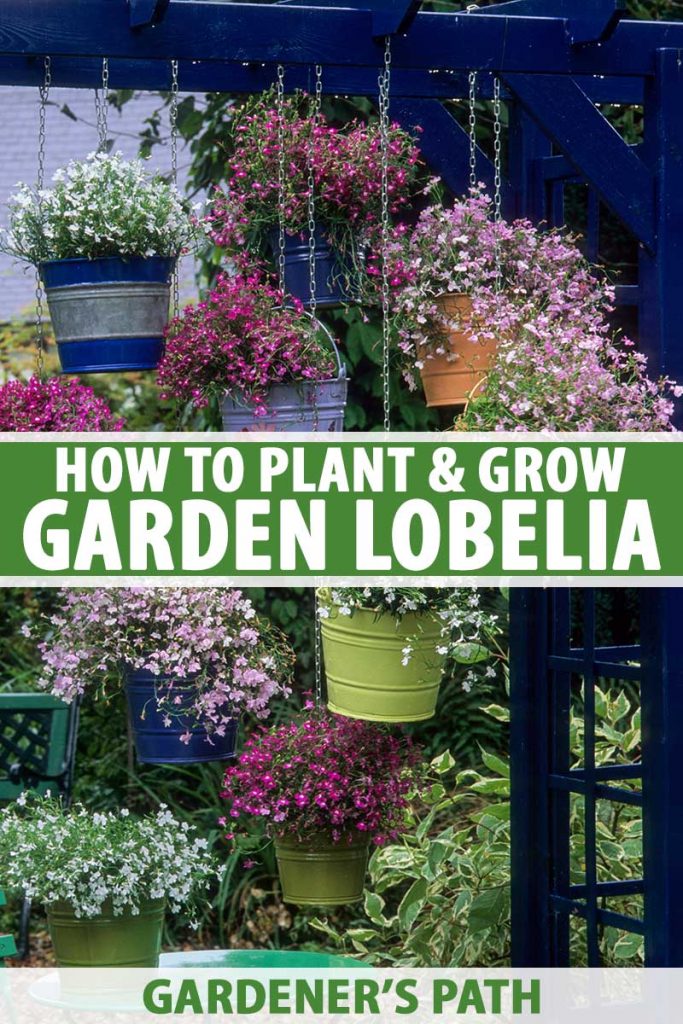
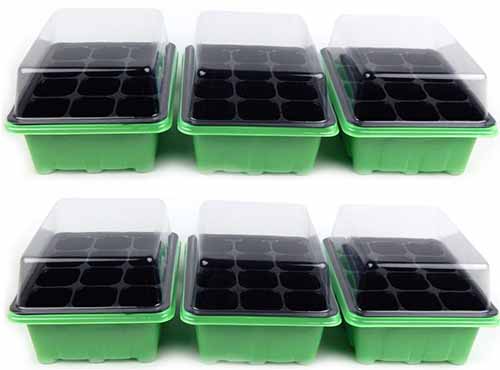
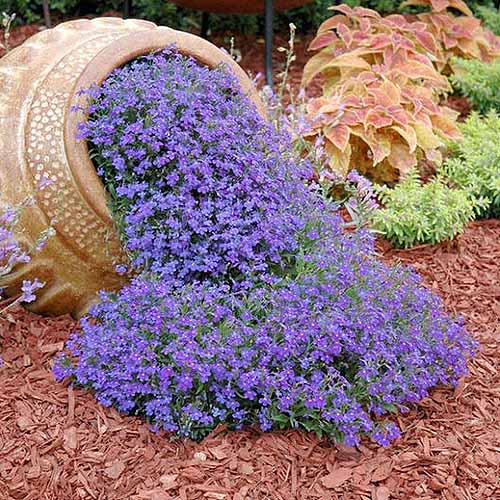


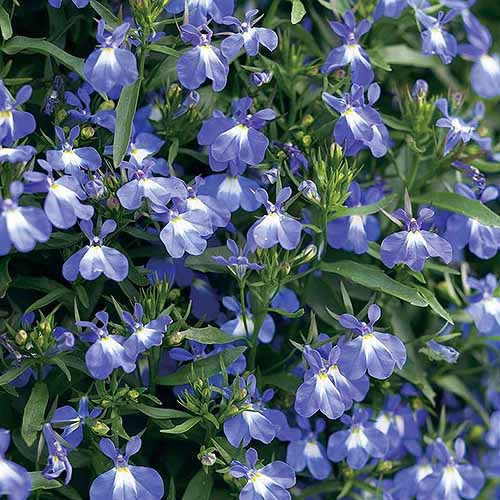
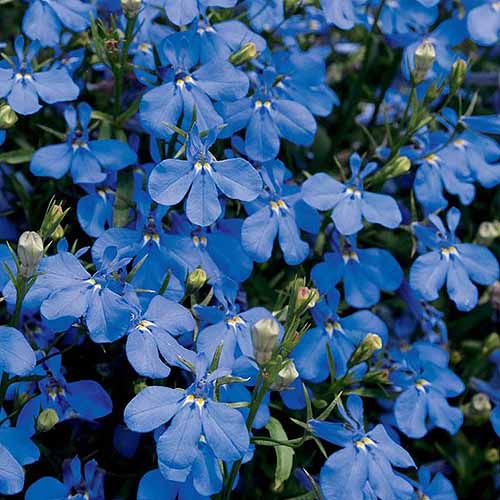
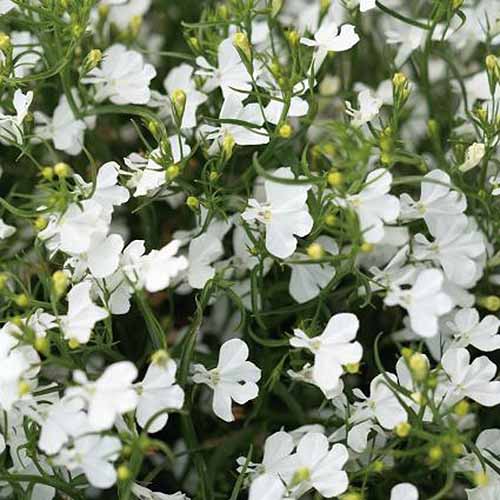
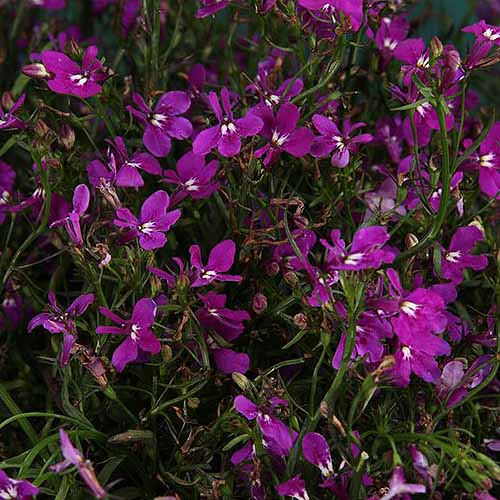
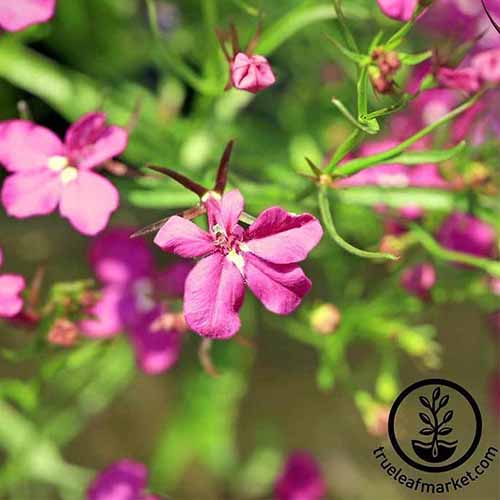

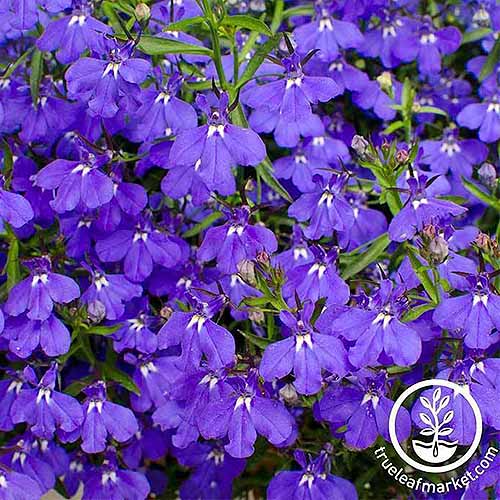




Lots of great info! Thanks
Good to hear, thanks Gay!